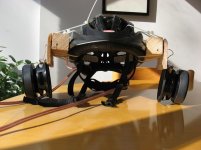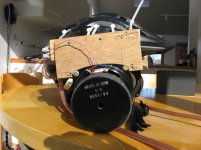It sounds difficult to do well but could be fun. Does anyone do this?
If so what would you use and where might I find some design information?
I had a pair of (pretty expensive) skullcandys that broke due to terrible build quality and I was thinking about ripping the drivers out of them and making some diy ones, just a low budget side project
If so what would you use and where might I find some design information?
I had a pair of (pretty expensive) skullcandys that broke due to terrible build quality and I was thinking about ripping the drivers out of them and making some diy ones, just a low budget side project
wow, you bought skullcandies? arent they just emo bose?
I wouldnt waste my time with those drivers. people do indeed make their iwn headphones, but unless its totally about the journey rather than the result, i would start with something that could be more readily turned into something useful and that need not cost you much to find the donor headphones. there are threads in this forum about DIY electrostatic headphones and probably if you search you might find some dynamics, but yeah i would just throw the skullcandies in the trash
I wouldnt waste my time with those drivers. people do indeed make their iwn headphones, but unless its totally about the journey rather than the result, i would start with something that could be more readily turned into something useful and that need not cost you much to find the donor headphones. there are threads in this forum about DIY electrostatic headphones and probably if you search you might find some dynamics, but yeah i would just throw the skullcandies in the trash
Last edited:
After that I learned the error of my ways. Now I've got some old Bose ones which are much better but their falling apart
Apparently not.
yeah, I mentioned that, but didnt bother linking, as i took it for being a little more than the OP bargained for when posing the question. i doubt he had in mind fabricating stators to run several hundred volts next to his ears and building the required amp to run them. not usually the next step after skullcandy.
hehe bose better, bose = more expensive, but better? i think not, as hes found out
hehe bose better, bose = more expensive, but better? i think not, as hes found out
I have actually had good experience with bose headphones. I'm sure there are better ones but for the price range compared to other headphones (I.e. beats) and so far I haven't heard better (given a small sample size).
I looked at some electrostatic headphone projects and I was actually pretty interesting. It looks tricky to do well on a first attempt without a cnc but I'm up for a challenge. I couldn't find any approx cost listings on the pages I read. Does anyone know like a baseline cost I should expect for some DIY electrostatic headphones?
I looked at some electrostatic headphone projects and I was actually pretty interesting. It looks tricky to do well on a first attempt without a cnc but I'm up for a challenge. I couldn't find any approx cost listings on the pages I read. Does anyone know like a baseline cost I should expect for some DIY electrostatic headphones?
my guess is given those comments and the previous purchases you mention, that you are only comparing to pretty average quality but expensive headphones. there are much better than bose for a considerably lower price; just like all their gear you pay for the name and the 'style' not the substance.
your question about the electrostats is far too general to give an answer to and without your own, or easy access to a cnc, the cost will be much higher. then you will also have to buy, or build an electrostatic amp and this is not something i would recommend for anything below a fairly advanced diyer
your question about the electrostats is far too general to give an answer to and without your own, or easy access to a cnc, the cost will be much higher. then you will also have to buy, or build an electrostatic amp and this is not something i would recommend for anything below a fairly advanced diyer
We used to hot glue little speakers in our motorcycle helmets, they sounded great.
I like the approach of ODougbo. I bolted a pair of 4'' wide-band speakers to a bicycle helmet via wood offsets. Heavy weight relative to common headphones from their big magnets. Not pretty either ! I drove them with a transconductance power amp. They sound great. Pictures are attached; front and side views. The woodframe allows for bolting other speakers instead; like the automotive Boston Acoustics SE75 4'' by 6" speaker. It is a two way design. They too sounded great; especially articulate in the mid to high end.
Attachments
Try a transconductance amp to drive headphones.
Please go to the thread " A headphone Transconductance Amp for a change!". It shows a practical circuit [Headphone001.pdf] which I used to drive the bicycle helmet headphones. Loudspeakers behave differently when driven by the common voltage source amp of low output impedance versus a current source or transconductance amp of high output impedance. The website www.firstwatt.com has articles by Mr. Pass which discusses them.
Please go to the thread " A headphone Transconductance Amp for a change!". It shows a practical circuit [Headphone001.pdf] which I used to drive the bicycle helmet headphones. Loudspeakers behave differently when driven by the common voltage source amp of low output impedance versus a current source or transconductance amp of high output impedance. The website www.firstwatt.com has articles by Mr. Pass which discusses them.
Chances R you have an idle bicycle safety helmet. Let's build a pair of high fidelity headphones with/on it!. I have such a helmet made by Bell. Bell [its maker] and dB sound pressure are an accidental coincidence here. I had bought for this simple project two 4" Die Cast Aluminum Cone Woofers [both were on sale for $20] from MCM Electronics; Part # 55-3853. The specifications for this wideband driver are at www.mcmelectronics.com. Noteworthy is its frequency response of 60 Hz to 15 KHz. Here are several reasons to assemble this headphone:
Best regards
- A strong rival for commercial headphones. Why not? After all, one normally puts such drivers in boxes, and drives them with diy or exotic amplifiers and then exhales whao, ooh, aah; what great sound. Their sound in this [headphones] application is [expected] to be better than that in boxes. Close to the ear; meaning a trivial cone excursion = high linearity = or low distortion, and no interferference by the walls of the listening room. We all strive for this high fidelity outcome in our builds regardless of the contraption
- Any diyAudio project must eventually make sound and reproduce music. Here it is. Your diy amplifier will drive a real loudspeaker.
- I use the helmet headphones to assess my diy amplifiers and simultaneously enjoy music. I hear everything.
- This build does no require a knowledge of acoustics and electronics. Just bolt the drivers to the helmet. Ensure symmetry around your head and ears.
- Wideband drivers up to 8" are useable in this application. I used a pair of 8" Radio Shack drivers with concentric whizzers. Worked great.
- The reproduced music from the helmet headphones is outside one's head [3D] unlike that reproduced with standard headphones which maybe be flat and in one's head. IMHO; step aside Grado and STAX!
Best regards
I make my own electrostatic headphones. 
http://www.diyaudio.com/forums/headphone-systems/132573-has-anybody-made-els-headphone.html
Wachara C.
http://www.diyaudio.com/forums/headphone-systems/132573-has-anybody-made-els-headphone.html
Wachara C.
Haha thats a great pic.
The thing I immediately think of though is that most headphones produce bass by pressurizing the small volume between the ear and headphone. Basically the same concept as cabin gain in a room or car. Without that seal the bass wouldn't be as good.
It seems that if you found a way to make a seal you could use much smaller drivers, like 3"-4" fostex drivers that would have a much improved high range while still producing just as much if not more bass.
The frequency response of a driver infinite baffle is going to be practically meaningless on the low end. What I mean is that driver you mentioned with 60hz - 15000hz range would actually produce muuuucccch more bass with a seal, I would guess easily down to 15Hz or lower. This is why you can hear bass from tiny ear buds with resonant frequencies in the hundreds.
I'd be tempted to get a pair of over the ear hearing protection sort of headphone type things and mount a 3" tang band driver in it making sure to get a good seal. The things you mentioned earlier about low excursion and distortion would all be true
The thing I immediately think of though is that most headphones produce bass by pressurizing the small volume between the ear and headphone. Basically the same concept as cabin gain in a room or car. Without that seal the bass wouldn't be as good.
It seems that if you found a way to make a seal you could use much smaller drivers, like 3"-4" fostex drivers that would have a much improved high range while still producing just as much if not more bass.
The frequency response of a driver infinite baffle is going to be practically meaningless on the low end. What I mean is that driver you mentioned with 60hz - 15000hz range would actually produce muuuucccch more bass with a seal, I would guess easily down to 15Hz or lower. This is why you can hear bass from tiny ear buds with resonant frequencies in the hundreds.
I'd be tempted to get a pair of over the ear hearing protection sort of headphone type things and mount a 3" tang band driver in it making sure to get a good seal. The things you mentioned earlier about low excursion and distortion would all be true
Here is some links to my little compact driver,
http://www.diyaudio.com/forums/planars-exotics/158115-material-esl-2.html#post2074212
http://www.diyaudio.com/forums/planars-exotics/158115-material-esl-2.html#post2076459
and,
http://www.diyaudio.com/forums/head...anybody-made-els-headphone-7.html#post2504556
They had good bass just holding them up to my ear !!
This can have a response as high as 50Khz or better !!!
jer
http://www.diyaudio.com/forums/planars-exotics/158115-material-esl-2.html#post2074212
http://www.diyaudio.com/forums/planars-exotics/158115-material-esl-2.html#post2076459
and,
http://www.diyaudio.com/forums/head...anybody-made-els-headphone-7.html#post2504556
They had good bass just holding them up to my ear !!
This can have a response as high as 50Khz or better !!!
jer
Last edited:
I make my own electrostatic headphones.
http://www.diyaudio.com/forums/headphone-systems/132573-has-anybody-made-els-headphone.html
Wachara C.
I commend you on your expertise to assemble such a delicate and precise transducer. Meticulous, and patient are some of the strong points of your personality.
Here is some links to my little compact driver,
http://www.diyaudio.com/forums/planars-exotics/158115-material-esl-2.html#post2074212
http://www.diyaudio.com/forums/planars-exotics/158115-material-esl-2.html#post2076459
and,
http://www.diyaudio.com/forums/head...anybody-made-els-headphone-7.html#post2504556
They had good bass just holding them up to my ear !!
This can have a response as high as 50Khz or better !!!
jer
I commend you on expertise. Working with sub-millimeter distances demands accuracy and a very patient person.
- Status
- This old topic is closed. If you want to reopen this topic, contact a moderator using the "Report Post" button.
- Home
- Amplifiers
- Headphone Systems
- Does anyone make their own headphones?

